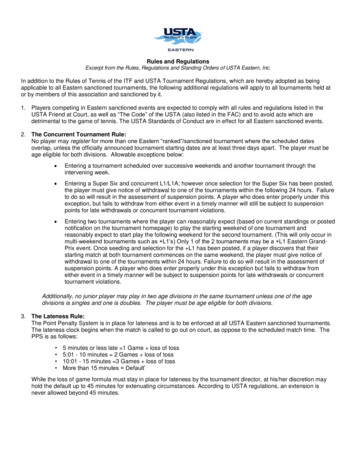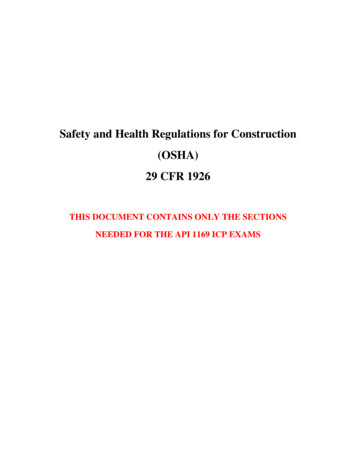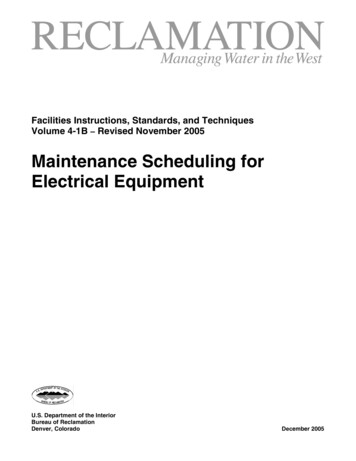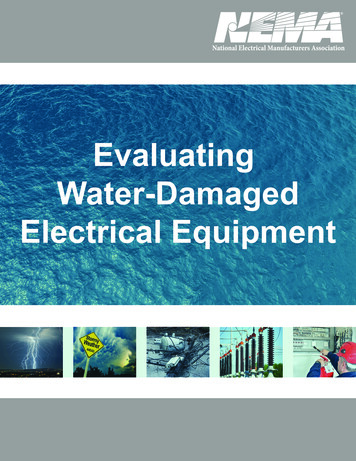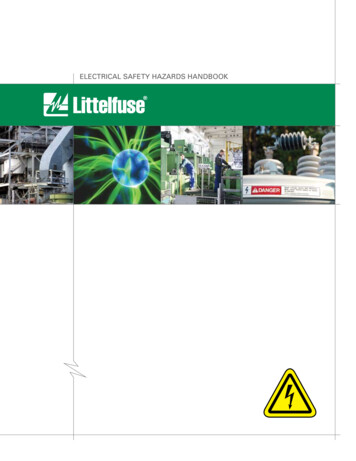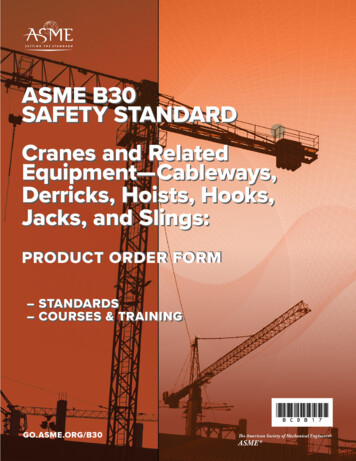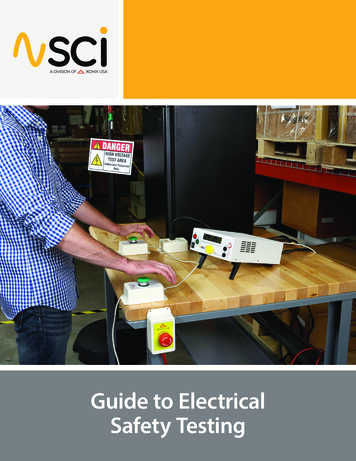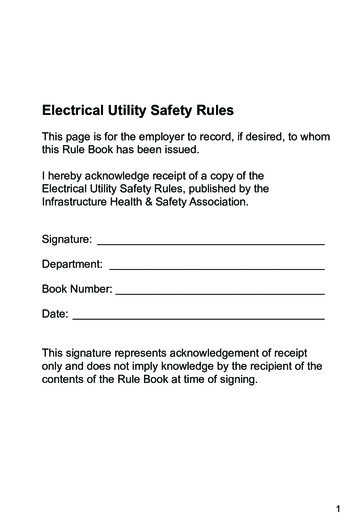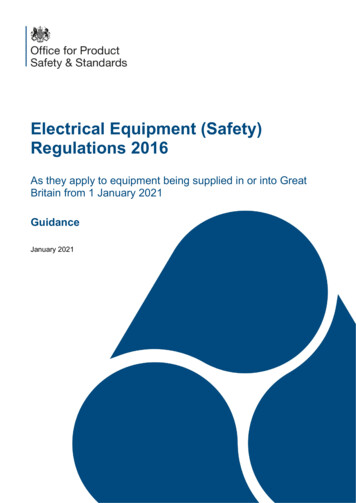
Transcription
Office for ProductSafety & StandardsElectrical Equipment (Safety)Regulations 2016As they apply to equipment being supplied in or into GreatBritain from 1 January 2021GuidanceJanuary 20211
Electrical Equipment (Safety) Regulations 2016: Guidance (GB)ContentsGuidance .31.Introduction.32.Legislative Background.33.Scope .44.Obligations of manufacturers.45.Obligations of authorised representatives.56.Obligations of importers.57.Obligations of distributors .88.Transitional arrangements .99.UKCA Marking .910.Qualifying Northern Ireland Goods .1011.Enforcement and penalties .1012.Glossary .112
Electrical Equipment (Safety) Regulations 2016: Guidance (GB)Guidance1.IntroductionThis Guide is for businesses placing electrical equipment products on the market in GreatBritain from 1 January 2021 1. If you are placing electrical equipment products on themarket in Northern Ireland, you should read separate s/electrical-equipment-safety-regulations-2016This Guide is designed to help you comply with The Electrical Equipment (Safety)Regulations 2016, as amended by the Product Safety and Metrology etc. (Amendmentetc.) (EU Exit) Regulations 2019 (referred to in this document as the “2016 Regulations”).The 2016 Regulations set out the requirements that must be met before electricalequipment products can be placed on the GB market. The purpose of the legislation is toensure safe products are placed on the GB market by requiring manufacturers to showhow their products meet the principal elements of the safety objectives.2.Legislative BackgroundThe Electrical Equipment (Safety) Regulations 2016 implemented EU Directive(2014/35/EU) on electrical equipment designed for use within certain voltage limits(commonly called the Low Voltage Directive). The EU Withdrawal Act 2018 preserves theRegulations and enables them to be amended so as to continue to function effectively nowthat the UK has left the EU. Accordingly, the Product Safety and Metrology etc.(Amendment etc.) (EU Exit) Regulations 2019 2 fix any deficiencies that arose from the UKleaving the EU (such as references to EU institutions) and make specific provision for theGB market.There is therefore one set of UK 2016 Regulations, but some of the provisions applydifferently in NI for as long as the Northern Ireland Protocol is in force. References to the2016 Regulations in this guide are references to those Regulations as they apply in GreatBritain. For guidance on placing on the Northern Ireland market, please ctrical-equipment-safety-regulations-201612The Implementation or Transition Period officially ends at 11pm on 31 December 2020; therefore, references to 1January 2021 should be read as meaning 11pm on 31 December 2020.The Product Safety and Metrology etc. (Amendment etc.) (EU Exit) Regulations 2019 were amended by the ProductSafety and Metrology etc. (Amendment to Extent and Meaning of Market) (EU Exit) Regulations 2020 to apply toGreat Britain only, and not to Northern Ireland, in support of implementing The Protocol of Ireland and NorthernIreland (“The Northern Ireland Protocol”). The Product Safety and Metrology etc. (Amendment etc.) (EU Exit)Regulations 2019 were further amended by the Product Safety and Metrology etc. (Amendment etc.) (UK(NI)Indication) (EU Exit) Regulations 2020 to provide for a 24 month transition period for importer labelling (for goodsfrom the EEA) and the UKCA marking, to amend the definition of “authorised representative” as well as introducingan end (in 12 months from the end of the Transition Period) to the recognition of goods meeting EU requirements, aswell as introducing provisions for qualifying Northern Ireland goods.3
Electrical Equipment (Safety) Regulations 2016: Guidance (GB)3.ScopeThe Regulations apply to all electrical equipment that is designed or adapted for usebetween 50 and 1,000 volts (in the case of alternating current) and 75 and 1,500 volts (inthe case of direct current). The Regulations cover domestic electrical equipment andequipment that is intended for use in the workplace.The Regulations do not apply to electrical equipment listed in Regulation 3 (2) of theRegulations.4.Obligations of manufacturersA manufacturer is a person who manufactures electrical equipment, or has electricalequipment designed or manufactured, and markets that equipment under their name ortrademark.The obligations of manufacturers of electrical equipment include:341.Before placing electrical equipment on the GB market, the manufacturer mustensure that the equipment has been designed and manufactured in accordance withthe principal elements of the safety objectives. These are set out in Schedule 1 tothe Regulations. Manufacturers must also have a relevant conformity assessmentprocedure carried out and technical documentation drawn up.2.Once this has been done, the manufacturer must draw up a declaration ofconformity 3, and affix the UKCA marking 4 visibly, legibly and indelibly to theequipment. Where this is not possible or warranted because of the nature of theequipment, the UKCA marking must be affixed on the packaging and accompanyingdocuments. In any event, until 31 December 2022, the UKCA marking may beaffixed to a label or a document accompanying the equipment.3.Qualifying Northern Ireland goods can be placed on the GB market with the CE andCE UKNI conformity markings, see further detail in Section 10 on QualifyingNorthern Ireland Goods4.Manufacturers must keep technical documentation and the declaration of conformityfor 10 years after the equipment has been placed on the GB market and make themavailable for inspection to the market surveillance authority.5.Manufacturers must also label the equipment with their name, registered tradename or registered trade mark and address; the type batch or serial number (orother identification); and ensure that it is accompanied by instructions which areclear, legible and in easily understandable English.6.Manufacturers must ensure that procedures are in place for series production toremain in conformity with Part 2 of the 2016 Regulations. In doing so, they musttake account of any changes in electrical equipment design or characteristics, andany change in a harmonised standard or in another technical specification byreference to which the EU Declaration of Conformity was drawn up.A Declaration of Conformity is a document that declares that the product is in conformity with the relevant statutoryrequirements applicable to the specific product.Until 31 December 2021, equipment conforming to EU rules, including the CE marking, may be placed on the marketof Great Britain.4
Electrical Equipment (Safety) Regulations 2016: Guidance (GB)7.Manufacturers must, when appropriate with regard to any risk posed to consumers,carry out sample testing of equipment they have placed on the GB market and mustinvestigate any complaints that the electrical equipment is not in conformity with thelegal requirements of the 2016 Regulations and keep records of these complaints.8.Manufacturers must take action where they have reason to believe that the electricalequipment they have placed on the GB market is not in conformity with the legalrequirements of the 2016 Regulations; where the equipment presents a risk, themanufacturer must immediately inform the market surveillance authority.9.Manufacturers must also cooperate with and provide information to enforcingauthorities, such as local trading standards authorities, following any reasonedrequests within 10 years of placing the equipment on the market.Manufacturers based in Northern Ireland can follow the legislation as it applies to NorthernIreland and place qualifying Northern Ireland goods on the GB market without anyadditional approvals. See further detail in Section 10 on Qualifying Northern IrelandGoods.5.Obligations of authorised representativesManufacturers are able by written mandate to appoint authorised representatives toperform certain tasks on their behalf.Mandated authorised representatives for the GB market can be based in GB or NorthernIreland but after 1 January 2021 cannot be based outside the UK. A manufacturer can onlymandate an authorised representative established in the UK under the Regulations as theyapply in GB.No GB-based authorised representatives are recognised under EU law to carry out taskson the manufacturer’s behalf for equipment being placed on the EU market. This meansthat GB based authorised representatives cannot carry out tasks on the manufacturer’sbehalf for products being placed on the Northern Ireland or EEA markets. Therefore, a GBmanufacturer selling equipment to the EEA or into Northern Ireland, who wishes to appointan authorised representative to carry out tasks for them in respect of that equipment, mustappoint an authorised representative based in Northern Ireland or the EEA.An authorised representative must comply with the duties imposed on the manufacturer, inparticular, regulation 7 (retention of technical documentation) and regulation 13 (provisionof information and cooperation), as well as perform other tasks which the mandateappoints them to perform.The manufacturer remains responsible for the proper performance of any duties theauthorised representative performs on their behalf.Any references in the 2016 Regulations to the manufacturer are to be taken to include areference to the authorised representative including in relation to penalties for failure tocomply with those duties.6.Obligations of importersAn importer is a person or business based in the UK who places equipment on the GBmarket from a country outside the UK. This means that UK businesses which used to actas a ‘distributor’ before the end of the transition period legally become an ‘importer’ if theyplace products from an EEA country on the GB market.5
Electrical Equipment (Safety) Regulations 2016: Guidance (GB)This includes electrical equipment that is supplied to NI businesses from the EEA and thenplaced on the GB market. In this instance the NI business will take on importer obligationsfor EEA-supplied goods that are placed on the GB market (see also Section 10 onQualifying Northern Ireland Goods).Importers have additional legal obligations which go beyond those of distributors, such aschecking that manufacturers have carried out the right conformity assessment proceduresand including their (the importer’s) name, registered trade name or mark and a postaladdress on the equipment or, where this is not possible, on its packaging or inaccompanying documentation.To assist with the transition, the UK is applying a transitional period ending on 31December 2022 to allow UK distributors of goods from the EEA or Switzerland whobecome importers into the GB market to provide their details on the packaging or inaccompanying documentation as an alternative to placing them on the equipment itself(even if it is otherwise possible to affix it to the electrical equipment itself). This applies togoods that are not qualifying Northern Ireland goods. For further detail on qualifyingNorthern Ireland goods, please see Section 10 on Qualifying Northern Ireland Goods.Can you be contacted easily if there is a problem?A key principle underpinning product safety, for the benefit of consumers andregulators, is traceability of a product back to its source.In recognition that under the new regulatory regime you may have the new status of animporter when placing goods from an EEA state on the GB market for the first time, youmay provide your contact details by a document that accompanies the product. This willbe allowed until 31 December 2022.We understand that there may be a period of adjustment to the new arrangements forimporter documentation for the GB market, and it may be difficult to provide your detailson documentation accompanying each and every individual product.You may therefore use an alternative method where, for example, your contactinformation is on a document accompanying a batch of products. This document wouldthen follow each batch of products through the distribution chain. Your contact detailsmust follow each product through the distribution chain, but not necessarily by onedocument per product. Ultimately, the end user, each distributor (and a regulator) mustbe able to access the information.Methods which enable traceability of the product after the initial batch has been brokenup could include: The importer address is present in shipping documents. The importer address is present on the invoice to the GB customer. The importer address is present on the label that is on the outer packaging(“shipper”) in which a number of finished goods is packed (normally customerswill receive shippers unless the order is very small so that the shipper has to beopened and split). The importer address is included on the EU Declaration of Conformity and/or UKDeclaration of Conformity (whichever is relevant for the product in question).6
Electrical Equipment (Safety) Regulations 2016: Guidance (GB)You should work with your distributors to ensure physical documentation doesaccompany batches of product as far as possible, and in all cases that there aremeasures in place to ensure end users are able to identify the UK importer.Alongside that, but not as an alternative, you can use your company website to providemore information, access to product details and contact points for retailers, consumersand enforcement bodies.These options are for a time limited period only and may not be used after 31December 2022. You are encouraged to put in place measures to ensure that individualitems do carry the importer’s address where required ahead of this date.The EU does not have any such transitional provision. In the absence of this, equipmentbeing sold from GB to NI or the EU must be labelled with the NI or EU-based importer’saddress. For further detail about placing on the NI market please ctrical-equipment-safety-regulations-2016The obligations of importers in the UK include:51.Before placing electrical equipment on the GB market, the importer must ensure thatit is in conformity with the principal elements of the safety objectives and that theobligations in the 2016 Regulations have been met. If the electrical equipmentpresents a risk, the importer must inform the manufacturer and the marketsurveillance authority of that risk.2.The importer must ensure that the relevant conformity assessment has been carriedout by the manufacturer; the manufacturer has drawn up the technicaldocumentation; the manufacturer has affixed the UKCA marking 5, to the equipmentand has drawn up the declaration of conformity. Until 31 December 2022, the UKCAmarking may be affixed to a label affixed to, or a document accompanying, theequipment; this applies even where it would otherwise be possible to affix the UKCAmarking to the equipment.3.The importer must keep a copy of the declaration of conformity and technicaldocumentation for a period of 10 years after the equipment has been placed on theGB market.4.The importer must provide their name, registered trade name and a postal addressat which they can be contacted on the electrical equipment or on its packaging or inan accompanying document.5.The importer must ensure that equipment is accompanied by instructions which arein easily understandable English.6.The importer must, when appropriate with regard to any risk posed to consumers,carry out sample testing of equipment they have placed on the GB market andinvestigate complaints about electrical equipment that is not in conformity with thelegal requirements of the 2016 Regulations and keep a register of those complaints.Until 31 December 2021, equipment conforming to EU rules, including the CE marking, may be placed on the marketof Great Britain – see below; qualifying Northern Ireland goods complying with NI rules, including the CE marking,may also be placed on the GB market – see below.7
Electrical Equipment (Safety) Regulations 2016: Guidance (GB)7.The importer must take action where they have reason to believe that the electricalequipment they have placed on the GB market is not in conformity with the legalrequirements of the 2016 Regulations.8.The importer must ensure that while electrical equipment is under theirresponsibility, its storage and transport conditions do not jeopardise its conformitywith the essential health and safety requirements.9.The importer must also cooperate with and provide information to enforcingauthorities following any requests.Qualifying Northern Ireland goods complying with the legislation as it applies in NorthernIreland, including affixing the CE marking, may also be placed on the GB market. Seefurther detail in Section 10 on Qualifying Northern Ireland Goods.7.Obligations of distributorsUK businesses that were distributors of electrical equipment within the EU single marketshould now consider whether they are importers from the EU single market and thereforewhat additional responsibilities they may have – see section 6 above. The same applies todistributors of goods from the EEA and Switzerland.A distributor is any person, other than the manufacturer or importer, who makes electricalequipment available on the GB market.The obligations of distributors include:61.When making electrical equipment available on the GB market, the distributor mustact with due care to ensure that it is in conformity with the principal elements of thesafety objectives and that the obligations in the 2016 Regulations have been met.2.Where a distributor considers that the equipment is not in conformity with theprincipal elements of the safety objectives, they must not make the equipmentavailable on the GB market until it has been brought into conformity.3.Before making equipment available on the GB market, the distributor must verifythat the equipment bears the UKCA marking 6; is accompanied by the requiredinstructions and safety information; and that the importer and manufacturer havecomplied with their obligations as to required labelling. The distributor must takeaction where they have reason to believe that the electrical equipment that theyhave made available on the GB market is not in conformity with the 2016Regulations. Until 31 December 2022, the UKCA marking may be affixed to a labelaffixed to, or a document accompanying, the equipment.4.The distributor must also cooperate with and provide information to enforcingauthorities following any requests.Until 31 December 2021, equipment conforming to EU rules, including the CE marking, may be placed on the marketof Great Britain – see below; qualifying Northern Ireland go
Electrical Equipment (Safety) Regulations 2016: Guidance (GB) 7. Manufacturers must, whe
